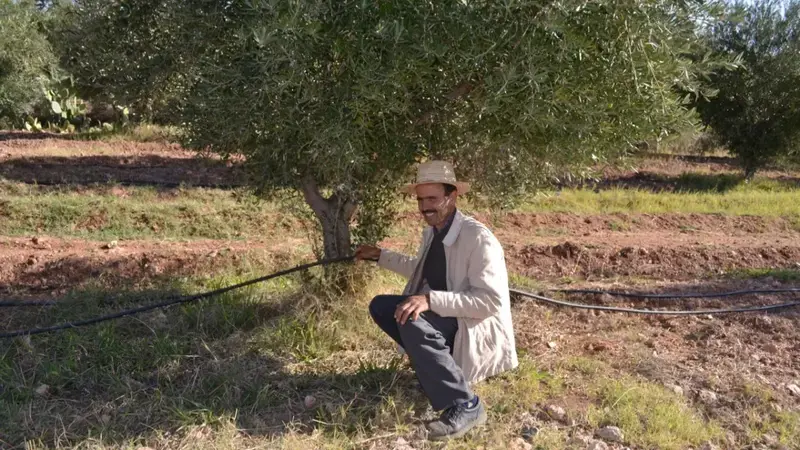Growing more olives with less water

Bensadek El Mokhtar and his two sons could only irrigate two of their nine hectares of land in Morocco using traditional flood irrigation. Although Morocco is set to nearly double the area, treble olive production, and quadruple olive oil output by 2020, these ambitious plans could have potentially serious consequences for the country’s water supplies.
Over 30 percent of the olive area in Morocco, like Bensadek’s farm, uses traditional flood irrigation, consuming water at levels far beyond what trees actually need for optimal production.
Leaky irrigation canals only make matters worse by wasting additional water in a country already facing water shortages. As rainfall in Marrakech region is 140 mm per year - far too little to support olives - it is impossible to grow olive trees without irrigation. Wasting water using traditional olive irrigation is a luxury farmers in this region simply can’t afford.
Drip Irrigation: applying water just around the base of the trees—can dramatically reduce the amount of water used for irrigation
The Plan Maroc Vert (or ‘Green Morocco Plan’) aims to increase the area of orchards using drip irrigation by 153,000 hectares, including both new and established orchards. The Government of Morocco is offering large subsidies to farmers who instal drip irrigation, covering 100 percent of the costs of equipment and trees for new orchards that are less than 5 hectares in size. Even large-scale farmers can get subsidies for 80 percent of the cost of drip-irrigation equipment.
As part of ICARDA’s efforts to identify and disseminate best practices for drip irrigation of olive orchards in Morocco, particularly deficit irrigation, the Center has been demonstrating the benefits of this technology through the Moroccan component of a four-year initiative - Program for the Development and Dissemination of Sustainable Irrigation Management in Olive Growing.
More efforts needed to promote drip irrigation
Only five to eight percent of land in the Marrakesh region is using drip irrigation. Alongside colleagues at the Institut National de la Recherche Agronomique (INRA), Dr. Vinay Nangia, a hydrologist working at ICARDA and project coordinator, conducted trials to investigate the efficiency of water use under traditional irrigation practices compared to drip irrigation. The results were overwhelming: drip-irrigated orchards start generating income a full year earlier than traditionally-managed orchards.
A complete production package that includes improved techniques for cultivation of the soil, keeping the land free of weeds, pest and disease control, fertigation [applying fertilizer through the irrigation water], and pruning, was introduced by ICARDA. This package has shown proven results in early maturity, rapid growth of the young trees, and a reduction of 70 percent in the amount of water used for irrigation - not to mention higher-quality of oil production using deficit irrigation.
Before switching to drip irrigation, Bensadek and his family could irrigate only two of their nine hectares of land. They now have enough water to irrigate all their land - three hectares of which are under olives and the rest planted to alfalfa and potatoes. Their olive yields have increased five times switching from flood irrigation to drip irrigation. Bensadek can now apply water when the trees need it most, and have enough left over to grow potatoes for sale and alfalfa to feed his cattle.
Switching from flood to drip irrigation
Not everyone is following the advice, however. Clearly, there is more to be done in getting the message about drip irrigation across to farmers, but early signs are that the project is on track to spread the word.
Mature olive trees that have been flood irrigated have wide-spreading, shallow root systems and lots of branches and leaves. Roots have to be pruned by deep plowing close to the trees when switching to drip irrigation to help concentrate the roots close to where the irrigation water will be applied. Trees, then, have to be pruned quite severely to balance the roots.
This puts off farmers from making the switch to drip irrigation because they think it will drastically reduce the yields of their trees and it will take years for the trees to recover. When ICARDA applied the trial at the Tessaout research station, they were quite surprised to find that yields dropped for only one year immediately after the pruning was done, but then recovered the following year.
Looking at the cost of irrigation water per kilogram of olives produced highlights the impact of drip irrigation on farmers’ income, especially when deficit irrigation is applied. Flood irrigation costs at least 22 percent of the final selling price of the olives, compared with between 8 and 11 percent for olives grown using deficit irrigation.
Despite conducting several field days to show farmers and extension agents the benefits of drip irrigation and deficit irrigation for mature orchards, we are still seeing farmers apply far too much water even with drip irrigation systems. Researchers need to find out why more farmers are not jumping at the chance to switch to drip irrigation. The benefits are so clear, and the government is subsidizing the equipment for drip irrigation, so it costs farmers little or nothing to implement.
The project doesn’t have all the answers yet, but ICARDA and its Moroccan colleagues are confident that they will bring the benefits of drip irrigation to Morocco’s olive farmers.
For more information on the Olive Irrigation Project visit: http://www.icarda.org/olive-lrrigation-project/teaser
